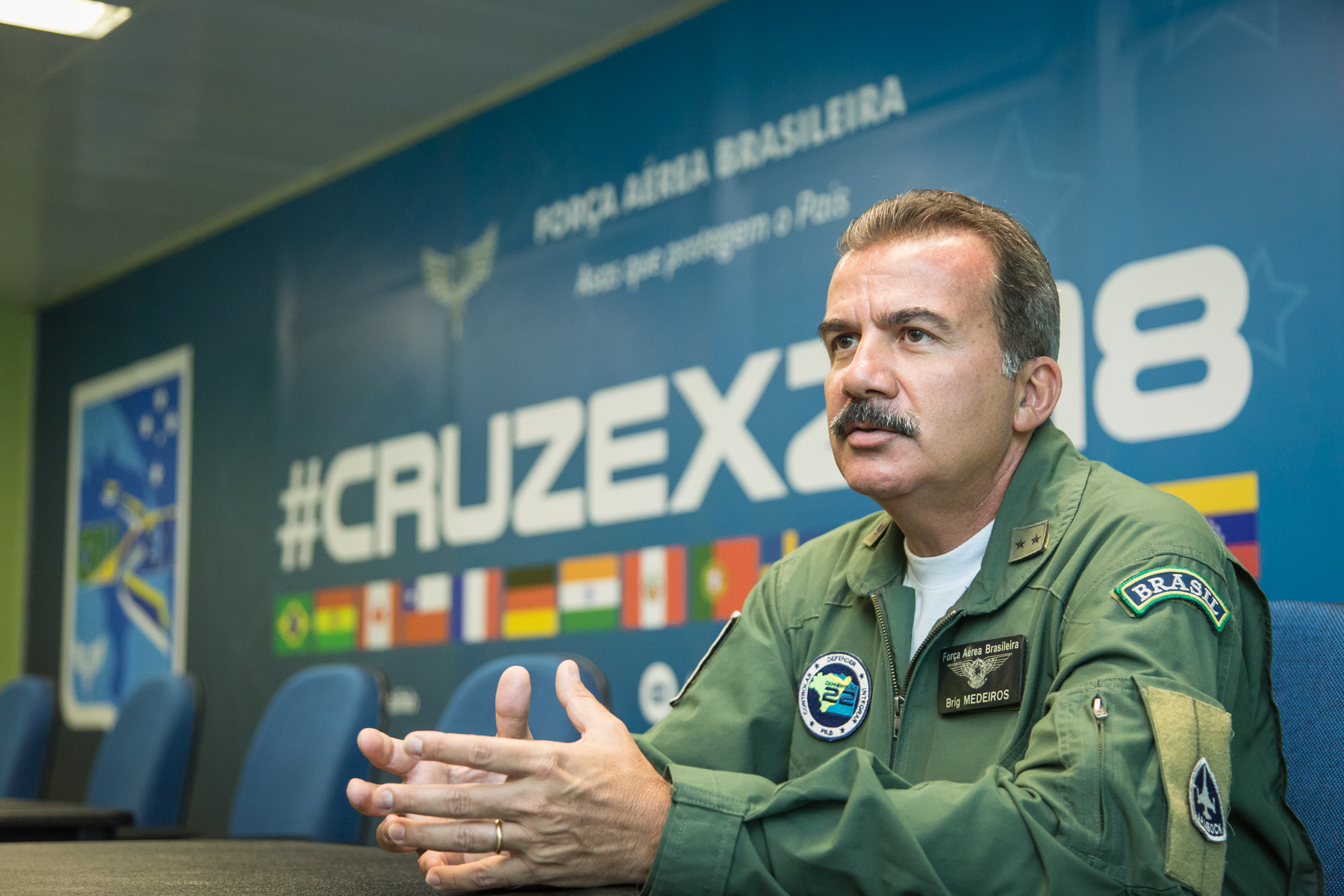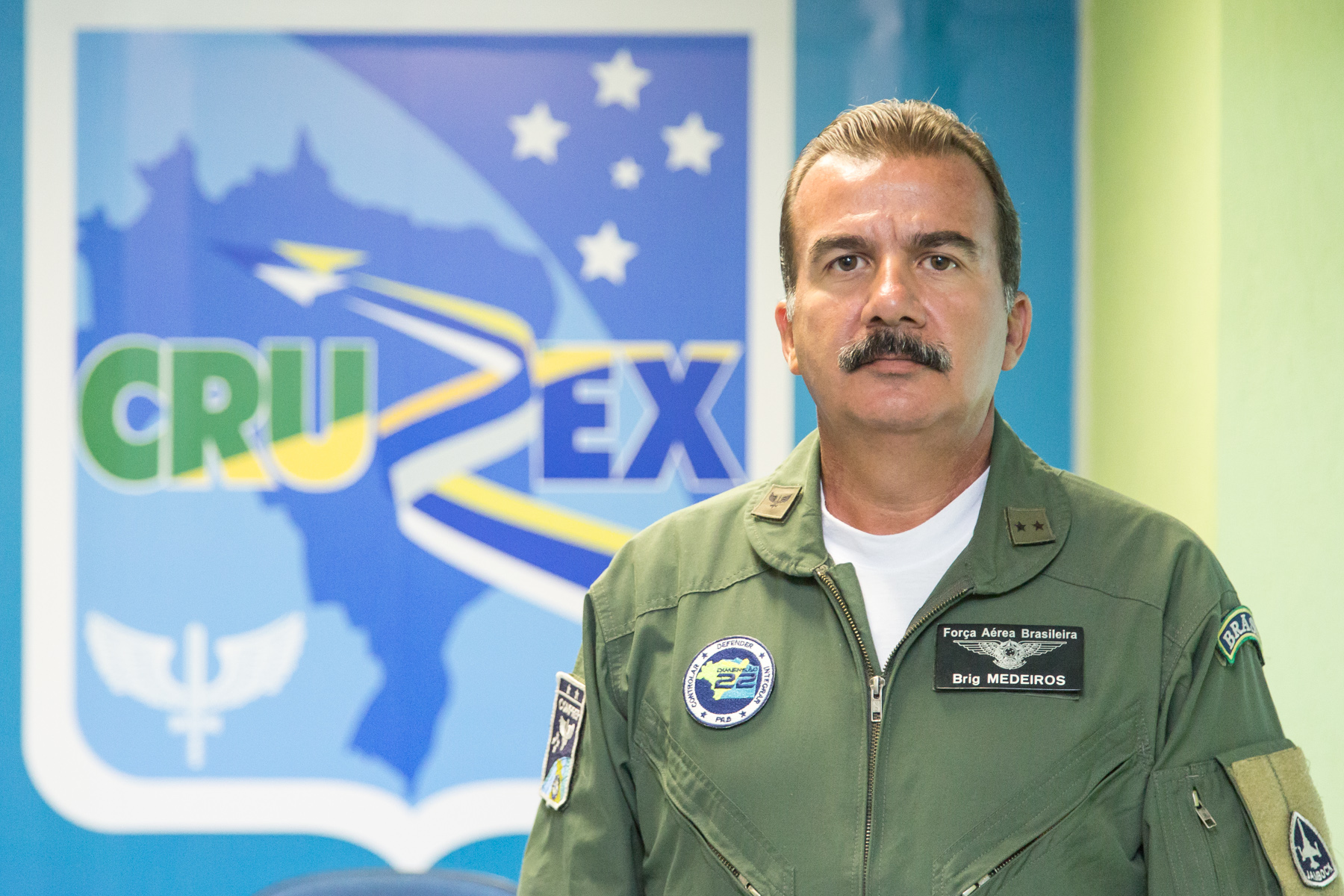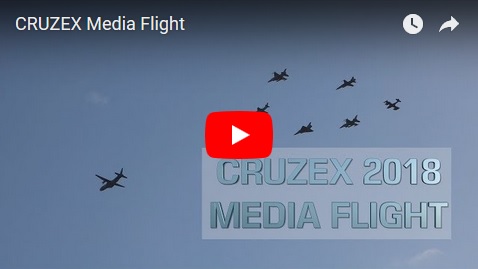 The conventional war scenario is already in training in CRUZEX 2018. The first Composite Air Operation (COMAO), translated in Brazilian doctrine as Composite Air MIssion, put together 59 aircraft of different types of aviation, involving all the countries that participating in the exercise with aerial means.
The conventional war scenario is already in training in CRUZEX 2018. The first Composite Air Operation (COMAO), translated in Brazilian doctrine as Composite Air MIssion, put together 59 aircraft of different types of aviation, involving all the countries that participating in the exercise with aerial means.
The first Mission Commander, that is, the pilot responsible for planning and coordinating all the mission was Major Felipe Scheer, from the Poker Squadron (1º/10º GAV). He explains that the complexity of this kind of action is the need to align actions among distinct doctrines, that vary as the country and the kind of aircraft in operation varies. It also aims the fulfilment a common goal. He mentions the fact that each airplane has particular flight profiles, speeds and distinct performances, and all those aspects have to be put into consideration. “The responsability and complexity of a mission increase as the type and number of involved aircraft increase”, says him.
After receiving a document called Air Task Order, where are all the actions to be executed by each COMAO player, the Mission Commander has only 24h to coordinate and execute the first takeoff. During this period, two meetings are organized - the initial coordination meeting e the final coordination meeting, in addition to a briefing with all the involved crew, the so-called mass briefing.
 In COMAO, dozens of aircraft takeoff in a short period of time to fulfill actions of complementary Air Forces, aiming at a common goal. To have a better idea, in the first CRUZEX 2018 COMAO, from 9h50 and 10h34, all the fighter aircraft took off - one at every three minutes. The airspace where the training takes place is also limited, increasing the complexity and creating the need of cleaning the roots.
In COMAO, dozens of aircraft takeoff in a short period of time to fulfill actions of complementary Air Forces, aiming at a common goal. To have a better idea, in the first CRUZEX 2018 COMAO, from 9h50 and 10h34, all the fighter aircraft took off - one at every three minutes. The airspace where the training takes place is also limited, increasing the complexity and creating the need of cleaning the roots.
In this scenario, the simulation of a country that executes offensive actions and a defensive action of another country take place. The defense group has been composed, in CRUZEX, by a number of four and eight fighters and one tanker. As important as the combat, is the coordination among dozens of aircraft with different profiles and specific doctrines, always putting flight safety as a priority.

In the first CRUZEX 2018 COMAO, all the countries participating in the exercise with aircraft - Canada, France, Chile, Uruguay, United States, Peru and Brazil - realized takeoffs. The A-1, A-29, A-4 and A-37 fighters executed strickers missions; the F-16, F-5 and Mirage executed air defense missions; the E-99 realized in-flight control and alarm and air communication; the KC-130 e KC-135 tankers executed air to air refuelling; the cargo aircraft, C-130, CC-130J, C-105 and C-235, realized airlifts, in this case, airdrop. The A-1 aircraft, equipped with a reconnaissance pod, also executed an tactical air reconnaissance, to analyse the damages caused by the strikers.
Text: Lieutenant Gabrielli Dala Vechia
Photograph: Seargents Johnson Barros e Bianca Viol
Translation: Lieutenant Ludmila Milhorance
 On this Tuesday and Wednesday (20 and 21), Brazilian and Chilean authorities have been in Ala 10, Natal (RN), oto follow the activities of Cruzeiro do Sul Exercise - CRUZEX 2018.
On this Tuesday and Wednesday (20 and 21), Brazilian and Chilean authorities have been in Ala 10, Natal (RN), oto follow the activities of Cruzeiro do Sul Exercise - CRUZEX 2018.
On Tuesday, the Defense Minister, Joaquim Silva e Luna, met the Air Force Commander, Lieutenant-General Nivaldo Luiz Rossato and the Preparation Commander (COMPREP), Lieutenant-General Antonio Carlos Egito do Amaral, in the training area. Check the video about the visit of Brazilian authorities and the flight of the Defense Minister in a fighter aircraft.
 The Director of the Exercise, General Luiz Guilherme Silveira de Medeiros, presented an overview of the training to Brazilian and Chilean authorities, on this Wednesday.
The Director of the Exercise, General Luiz Guilherme Silveira de Medeiros, presented an overview of the training to Brazilian and Chilean authorities, on this Wednesday.
The Chilean Defense Minister, Alberto Espina, and the Chilean Air Force Commander, General Arturo Bernardo Merino Núñez, followed by other delegation members, received information about previous editions of the exercise, its participants, goals and timeline.

General Medeiros emphasiezed the Chilean Air Force participation in the Exercise in previous years. He also talked about the participation of the Brazilian Army and Navy for the first time in the training. The officer highlighted another innovation: actions involving unconventional war, that is, an Armed Forces combat against insurgent or paramilitary forces and not between two constituted States. This is the kind of scenario found in UN peacekeeping missions. After the presentation, the authorities visited the Exercise facilities and followed some of the activities executed by the militaries from the 13 participating countries.
Text: Lieutenant Emília Maria
Photograph: Seargent Marcella Perez
Translation: Lieutenant Ludmila Milhorance
 Check how the flight of seven aircraft went during the exercise
Check how the flight of seven aircraft went during the exercise
On this Tuesday (20), CRUZEX 2018 realized a media flight - a special flight dedicated to communication professionals to capture images. On board of a C-105 Amazonas and a H-36 Caracal helicopter, about 40 photographers and cameramen were able to capture images of the airfield of Ala 10 and of a squadron formed by seven fighters.
The fighter aircraft are participating in the exercise. The formation was composed by one A-1M, one F-5M e one A-4, all Brazilian aircraft; two F-16 - one from Chile and one from the United States; one Uruguayan A-37 and one Peruvian Mirage 2000.
Check the photographs by Seargents Johnson Barros and Bianca Viol:









Undergraduate students of Journalism, Audiovisual Production and Publicity and Advertising will realize an internship in CRUZEX 2018
The Brazilian Air Force has partnered with the Potiguar University, in Natal (RN), to enable an internship of Social Communication students during CRUZEX 2018. During the training, thirteen university students of Journalism, Audiovisual Production and Publicity and Advertising will help with content production, such as news, articles, infographics, videos and podcasts, during the exercise coverage. The students will be supported by the Air Force Social Communications Center (CECOMSAER), the unit responsible for managing the communication processes, that has assembled a work cell to meet the demands of CRUZEX.
 According to Thiago Garcia, the professor responsible for the interns, the students were chosen in line with theirs interests, profiles and aptitudes. For him, the partnership promotes the integrated growth of the students, both theoretically and practically. The professor explains that the contact with the labour market enables the intern to develop characteristics, abilities and competences related to their growth as citizens and ethical professionals. “I believe that they will develop relationship capacities with the managers of each sector in CRUZEX, which is an operation composed by processes, hierarchy, flows and systems, in addition to resilience, as the exercise characteristics impose”, says the professor.
According to Thiago Garcia, the professor responsible for the interns, the students were chosen in line with theirs interests, profiles and aptitudes. For him, the partnership promotes the integrated growth of the students, both theoretically and practically. The professor explains that the contact with the labour market enables the intern to develop characteristics, abilities and competences related to their growth as citizens and ethical professionals. “I believe that they will develop relationship capacities with the managers of each sector in CRUZEX, which is an operation composed by processes, hierarchy, flows and systems, in addition to resilience, as the exercise characteristics impose”, says the professor.
One of the interns, Ana Aica Gomes da Costa, student in the fourth year of Journalism, tells that the invitation has aroused great interest in the group. It is an extremely new experience, a great chance of enrichment and professional growth. My expectation is that I can engage with dedication and learn everything I can about Journalism”, says the student, 19-year old.
 According to Colonel Rodrigo Fontes, from CECOMSAER, the unit responsible for the partnership, this is not the first time that CRUZEX uses students of Social Communications. For him, it is an important opportunity of exchanging knowledge and of learning with real situations in an operational exercise of this proportion. “The training not only involves a big aerial effort with more than one hundred aircraft – thirty of them belongs to foreign countries -, it also involves several initiatives in the Communication area, in which there are more than 150 participating press professionals. In addition to this, there is the necessity of content production to be released in different platforms. For the interns and us, it is a great growth opportunity”, says him.
According to Colonel Rodrigo Fontes, from CECOMSAER, the unit responsible for the partnership, this is not the first time that CRUZEX uses students of Social Communications. For him, it is an important opportunity of exchanging knowledge and of learning with real situations in an operational exercise of this proportion. “The training not only involves a big aerial effort with more than one hundred aircraft – thirty of them belongs to foreign countries -, it also involves several initiatives in the Communication area, in which there are more than 150 participating press professionals. In addition to this, there is the necessity of content production to be released in different platforms. For the interns and us, it is a great growth opportunity”, says him.
Texto: Lieutenant Tenente Gabrielli Dala Vechia
Photography: Seargents Bianca Viol e Marcela Perez
Translation: Lieutenant Ludmila Milhorance
About 100 press professionals and aviation specialized media participated in a press conference about the Cruzeiro do Sul Exercise - CRUZEX 2018 - this Monday (19). The Director of the exercise, General Luiz Guilherme, presented the main aspects of the training e answered to the questions, accompanied by representatives of seven countries.
Luiz Guilherme, presented the main aspects of the training e answered to the questions, accompanied by representatives of seven countries.
The Brazilian general talked about the goals, the structure and the schedule of CRUZEX. “The main goal is to improve interoperability, both with the Brazilian Army and Navy and also with foreign forces. That is why we need to train our combat equipments, that is, the personnel in ground and in flight”, highlights him.
 The representative of the Chilean Air Force, Major-General Leonardo Romanini Gutiérrez, emphasized that the joint action among the countries is already constant. “There is a permanent cooperation among us, through the Cooperation System among American Airlines Forces. This Exercise serves as a training to improve interoperability in real situations”, says him.
The representative of the Chilean Air Force, Major-General Leonardo Romanini Gutiérrez, emphasized that the joint action among the countries is already constant. “There is a permanent cooperation among us, through the Cooperation System among American Airlines Forces. This Exercise serves as a training to improve interoperability in real situations”, says him.
For the Canadian militaries, knowing and working with other countries is important in the case of a a joint action necessity. “Our governments understand that it is important to create professional and personal ties so that we are able to work better together, if it's necessary”, comments Major Eric Willrich.
 The Commander of Ala 149, American unit participating in the Exercise, Colonel Raul Rosario, thanked the support of the Brazilian Air Force since the planning of CRUZEX 2018 e also talked about the training goals. “The main goal is to operate together, like equals. Doing that in a safe way and increasing our level of preparation and readiness", says.
The Commander of Ala 149, American unit participating in the Exercise, Colonel Raul Rosario, thanked the support of the Brazilian Air Force since the planning of CRUZEX 2018 e also talked about the training goals. “The main goal is to operate together, like equals. Doing that in a safe way and increasing our level of preparation and readiness", says.
Text: Lieutenant Emília Maria
Photography: Seargent Bianca Viol
Translation: Lieutenant Ludmila Milhorance

The first FAM-FIT takeoffs have already started in CRUZEX 2018
CRUZEX 2018 FAM-FIT flights started this morning (19). The initials FAM-FIT stand for Familiarization Flight (FAM) and Forces Integration Training (FIT). This initial phase is fundamental to the execution of the main scenarios of regular warfare, which will be trained with the Composite Air Operations (COMAO), and irregular warfare.
“The first two days of exercise are dedicated to the pilots that do not operate in Natal, including Brazilians. The goal is to adapt the pilots to the aerodrome and the region”, says the Chief of the Control Division of CRUZEX, Colonel Francisco Bento Antunes Neto.
FIT flights are a preparation to COMAO - also known as package flight, in which several aircraft (around 50), of different kinds, takeoff in sequence to execute actions that aim a main goal, in a limited space and time. In this kind of flights, there is a division of what is done in a integrated way in COMAO. Fighter and transport aircraft, for example, execute their mission isolatedly, so that they are ready to act together in the package flights, which begin next Wednesday (20)
While FAM flights only happens in the first two days, FIT flights follow the exercise and will be performed during the afternoon.
The first FAM flight was executed by Jambock Squadron (10 GAVCA), which operates Brazilian F-5M, together with the Chilean F-16. According to Major Mighel, from Jambock Squadron, there were two fighters from each country, executing a navigation flight in a pre-planned circuit. “These flights are important to familiarize Brazilian and foreign pilots with ground procedures, communication frequencies, takeoff and landing procedures, operation characteristics in the region and the exercise scenario”, says Major Miguel.
Text: Lieutenant Gabrielli Dala Vechia
Photography: Sargento Bianca Viol
Translation: Lieutenant Ludmila Milhorance


The training gathers 13 countries and will happen until November, 30th
The opening of Cruzeiro do Sul Exercise - CRUZEX 2018 - happened this Sunday (18), with a general briefing and the official photo, that gathered almost 2000 Brazilian and foreign militaries and some of the aerial means that will participate in the Exercise organized by the Brazilian Air Force. The Exercise Director, General Luiz Guilherme Silveira de Medeiros, emphasizes that the priority is to keep the operational security. The general also highlights the importance of exchanging experiences. “To achieve an adequate level of training, this exchange of experiences is essential. CRUZEX is also important because of the interoperability: the Army and the Navy will participate in this edition, including the unconventional war scenario, which is one of the main innovations in this edition”, says him.
The Exercise Director, General Luiz Guilherme Silveira de Medeiros, emphasizes that the priority is to keep the operational security. The general also highlights the importance of exchanging experiences. “To achieve an adequate level of training, this exchange of experiences is essential. CRUZEX is also important because of the interoperability: the Army and the Navy will participate in this edition, including the unconventional war scenario, which is one of the main innovations in this edition”, says him.
The unconventional war scenario, mentioned by the Director, refers to a combat in the Armed Forces that is against insurgent or paramilitary powers and not against two constituted States. This is the kind of scenario found in the UN peacekeeping missions.
 CRUZEX is a multinational operational exercise held by the Brazilian Air Force since 2002. It aims the joint training of conflict scenarios, promoting exchange of experiences between the participating countries.
CRUZEX is a multinational operational exercise held by the Brazilian Air Force since 2002. It aims the joint training of conflict scenarios, promoting exchange of experiences between the participating countries.
This year's edition will happen in Ala 10, in Natal (RN), from November 18th and November 30th, and will gather 13 countries, including Brazil. It also will put together 2000 military personnel and 100 Brazilian and foreign aircraft. It is the largest joint multinational exercise promoted by the Brazilian Air Force.
Text: Lieutenant Emília Maria
Photography: Seargents Bianca Viol e Johnson Barros/CECOMSAER
Translation: Lieutenant Ludmila Milhorance
The Direction of CRUZEX F2018 informs that the United Kingdom, that was going to participate as an observer, has cancelled its participation in the Exercise.
The other countries will still be in the air activities and all the scheduled events are maintained.
CRUZEX is the greatest multinational aerial combat exercise in South America, with the participation of about one hundred aircraft and 1,700 militaries from Brazil, Canada, Chile, France, Peru, Uruguay, United States, Bolivia, India, Sweden, Venezuela, Portugal and Germany.

Few days before the training, the Director of CRUZEX 2018 talks about the exercise
General Medeiros, Commander of Ala 10 and Director of CRUZEX 2018, brings more details about the exercise, that will begin on November 18th.
Few days before the beginning of CRUZEX 2018, the greatest joint multinational exercise organized by the Brazilian Air Force, the training Director, General Luiz Guilherme Silveira de Medeiros, brings more details about it.
Which phase of CRUZEX is being executed in this moment?
A C-17 cargo aircraft from the United States has already arrived, on Thursday, 15th. However, it might not participate in the exercise. The other delegations are on the way here, as planned. The Brazilian squadrons are landing here in Ala 10. Today, in this aerodrome, we will have familiarization flights, known as FAM-FIT (Familiarization and Integration Training) to Brazilian pilots who do not usually fly here.
Why is CRUZEX so important? What kind of operational gains the Brazilian Air Force is expecting from this training?
The exercise is important for three reasons. First, because of the exchange of experiences. In 2002, the first edition of CRUZEX, we received three countries with aircraft and one sent a military observer. Today, we have seven countries that will participate with airplanes, and also the observers. That is, the evolution is clear. It is not for nothing that the number of interested people has increased. Second, CRUZEX is important because of the interoperability: in this edition, the Army and Navy will participate, even in the actions of unconventional war, which is one of the main innovations of this edition. In this kind of scenario, the conflict is not between two constituted States, but against insurgent powers. And, finally, the exercise is important because of the possibility of training our logistic and operational means. This is essential because, in the case of a conflict or of a displacement to attend a peace mission, we must have this expertise to execute it.
You talked about the evolution between the first edition and CRUZEX 2018. Could you mention any example of operational gains in the Air Force brought by this exercise over the years?
There are two important examples. Command and Control is one of them. Today, Brazil is highly developed and talks the same language of NATO countries. We can work in an integrated way with these countries. Another aspect is what we call shot validation, an activity that occurs in exercises like the Red Flag, from the United States Air Force. It is not only about reaching the targets, but evaluating the results and verifying how they are achieved. When we execute a simulation of in-flight weaponry employment, we are able of evaluating the levels of operational performance we have achieved. If the employment is real, it is much easier to do the verification, because we can see the armament hits the target. In the case of simulation, it is necessary to use systems in integrated ways.
 During the trainings, will there be activities gathering different countries?
During the trainings, will there be activities gathering different countries?
Yes. There will be in-flight refueling with aircraft from different countries, parachute launching performed by planes from other countries, among other examples. This is the most important part of exchanging experiences, because a great number of military that will be in action here have already been in conflict situations.
This is the first time we train the unconventional war scenario in CRUZEX. Why was it chosen for this edition?
The State necessities naturally evolve of the years. We have already trained our terrestrial means in peacekeeping missions, like the one happened in Haiti. Our naval assets have also been trained in the Lebanon mission, for example, that had a commander from the Brazilian Navy. Aerial means have only been used in transport missions. Now, we have entered a UN audit to use other aircraft in peacekeeping missions – for example, the Amazon C-105, H-6O Black Hawk and the Super Tucano A-29. These aircraft are already pre-approved to be employed. In the case of a necessity, we are ready to operate. So, the actions we will train in CRUZEX 2018 are tied to the unconventional war kind of conflict. These are very specific actions and, in these cases, the risk of collateral damage, that is, of reaching civilians or facilities that are not directly related to the conflict is very high.
Why investing in training in a pacific country like Brazil?
The Armed Forces belong to the Brazilian people. And, because of the characteristics of our country, they are more defense forces than attack forces; they serve to guarantee the defense of the country e its constituted powers. This is our mission e and the reason we have to be ready and this is why we are training here.
The Brazilian Air Force had a period of five years without CRUZEX. Why?
Between the last edition in 2013 and this edition, the country hosted major events, like the Confederations Cup, the World Cup and the Olympics. During these period, we had a great involvement of the three Armed Forces. We did not have enough resources to conduct an exercise of these proportions.
Interview By: Lieutenant Gabrielli Dala Vechia
Photography By: Seargent Bianca Viol
Translation By: Lieutenant Ludmila Milhorance





